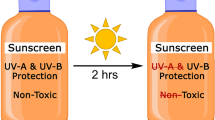Abstract
To clarify the health risks related to the use of zinc oxide (ZnO) nanoparticles, acute dermal toxicity, dermal irritation and corrosion, and skin sensitization were evaluated according to the guideline for Organization for Economic Cooperation and Development (OECD) and Good Laboratory Practice (GLP). In acute dermal toxicity test using rats, there were no treatment-related mortality, clinical signs of toxicity, body weight changes, and gross findings at a dose level of 2000 mg/kg. Similarly, dermal irritation and corrosion tests using rabbits revealed no mortality, clinical signs of toxicity, and acute irritation or corrosion reaction on the skin. In a skin sensitization test using guinea pigs, there were no significant mortality, clinical signs of toxicity, body weight changes, and skin reactions 24 and 48 h after the removal of challenge patch, which was scored “0” based on the Magnusson and Kligman grading scale. Our findings suggest that the nano-sized ZnO used in this study is relatively safe since it did not induce acute dermal toxicity, dermal irritation and corrosion, and skin sensitization.
Similar content being viewed by others
References
Zhang, Y., Nayak, T. R., Hong, H. & Cai, W. Biomedical applications of zinc oxide nanomaterials. Curr Mol Med 13:1633–1645 (2013).
Shi, L. E. et al. Synthesis, antibacterial activity, antibacterial mechanism and food applications of ZnO nanoparticles: a review. Food Addit Contam Part A Chem Anal Control Expo Risk Assess 31:173–186 (2014).
Straube, E. F., Schuster, N. H. & Sinclair, A. J. Zinc toxicity in the ferret. J Comp Pathol 90:355–361 (1980).
Lam, H. F., Conner, M. W., Rogers, A. E., Fitzgerald, S. & Amdur, M. O. Functional and morphologic changes in the lungs of guinea pigs exposed to freshly generated ultrafine zinc oxide. Toxicol Appl Pharmacol 78:29–38 (1985).
Wesselkamper, S. C., Chen, L. C. & Gordon, T. Development of pulmonary tolerance in mice exposed to zinc oxide fumes. Toxicol Sci 60:144–151 (2001).
Surekha, P. et al. Repeated dose dermal toxicity study of nano zinc oxide with Sprague-Dawley rats. Cutan Ocul Toxicol 31:26–32 (2012).
Lam, H. F., Chen, L. C., Ainsworth, D., Peoples, S. & Amdur, M. O. Pulmonary function of guinea pigs exposed to freshly generated ultrafine zinc oxide with and without spike concentrations. Am Ind Hyg Assoc J 49:333–341 (1988).
Fine, J. M. et al. Metal fume fever: characterization of clinical and plasma IL-6 responses in controlled human exposures to zinc oxide fume at and below the threshold limit value. J Occup Environ Med 39:722–726 (1997).
Cosma, G., Fulton, H., DeFeo, T. & Gordon, T. Rat lung metallothionein and heme oxygenase gene expression following ozone and zinc oxide exposure. Toxicol Appl Pharmacol 117:75–80 (1992).
Beckett, W. S. et al. Comparing inhaled ultrafine ver sus fine zinc oxide particles in healthy adults: a human inhalation study. Am J Respir Crit Care Med 171:1129–1135 (2005).
Wu, J. et al. Toxicity and penetration of TiO2 nanoparticles in hairless mice and porcine skin after subchronic dermal exposure. Toxicol Lett 191:1–8 (2009).
Osmond, M. J. & McCall, M. J. Zinc oxide nanoparticles in modern sunscreens: an analysis of potential exposure and hazard. Nanotoxicology 4:15–41 (2010).
Monteiro-Riviere, N. A. et al. Safety evaluation of sunscreen formulations containing titanium dioxide and zinc oxide nanoparticles in UVB sunburned skin: an in vitro and in vivo study. Toxicol Sci 123:264–280 (2011).
Kocbek, P., Teskac, K., Kreft, M. E. & Kristl, J. Toxicological aspects of long-term treatment of keratinocytes with ZnO and TiO2 nanoparticles. Small 6:1908–1917 (2010).
Meyer, K., Rajanahalli, P., Ahamed, M., Rowe, J. J. & Hong, Y. ZnO nanoparticles induce apoptosis in human dermal fibroblasts via p53 and p38 pathways. Toxicol In Vitro 25:1721–1726 (2011).
Ng, K. W. et al. The role of the tumor suppressor p53 pathway in the cellular DNA damage response to zinc oxide nanoparticles. Biomaterials 32:8218–8225 (2011).
Warheit, D. B. et al. Development of a base set of toxicity tests using ultrafine TiO2 particles as a component of nanoparticle risk management. Toxicol Lett 171:99–110 (2007).
Jeong, S. H. et al. Assessment of penetration of quantum dots through in vitro and in vivo human skin using the human skin equivalent model and the tape stripping method. Biochem Biophys Res Commun 394:612–615 (2010).
Patnaik, P. Handbook of Inorganic Chemicals (Mc-Graw-Hill, New York, 2003).
Oberdörster, G. Toxicology of ultrafine particles: in vivo studies. Trans R Soc Lond A 358:2719–2740 (2000).
Franklin, N. M. et al. Comparative toxicity of nanoparticulate ZnO, bulk ZnO, and ZnCl2 to a freshwater microalga (Pseudokirchneriella subcapitata): the importance of particle solubility. Environ Sci Technol 41: 8484–8490 (2007).
Karlsson, H. L., Gustafsson, J., Cronholm, P. & Möller, L. Size-dependent toxicity of metal oxide particles—a comparison between nano-and micrometer size. Toxicol Lett 188:112–118 (2009).
Zvyagin, A. V. et al. Imaging of zinc oxide nanoparticle penetration in human skin in vitro and in vivo. J Biomed Opt 13:064031 (2008).
Moos, P. J. et al. Responses of human cells to ZnO nanoparticles: a gene transcription study. Metallomics 3:1199–1211 (2011).
Cross, S. E. et al. Human skin penetration of sunscreen nanoparticles: in-vitro assessment of a novel micronized zinc oxide formulation. Skin Pharmacol Physiol 20:148–154 (2007).
Filipe, P. et al. Stratum corneum is an effective barrier to TiO2 and ZnO nanoparticle percutaneous absorption. Skin Pharmacol Physiol 22:266–275 (2009).
Schilling, K. et al. Human safety review of “nano” titanium dioxide and zinc oxide. Photochem Photobiol Sci 9:495–509 (2010).
OECD. Test Guideline 402. OECD Guideline for Testing of Chemicals. Acute Dermal Toxicity. France (1987).
OECD. Test Guideline 404. OECD Guideline for Testing of Chemicals. Acute Dermal irritation/corrosion. France (2015).
OECD. Test Guideline 406. OECD Guideline for Testing of Chemicals. Skin sensitization. France (1992).
Buehler, E. V. Occlusive patch method for skin sensitization in guinea pigs: th Buehler method. Food Chem Toxicol 32:97–101 (1994).
Author information
Authors and Affiliations
Corresponding author
Rights and permissions
About this article
Cite this article
Kim, SH., Heo, Y., Choi, SJ. et al. Safety evaluation of zinc oxide nanoparticles in terms of acute dermal toxicity, dermal irritation and corrosion, and skin sensitization. Mol. Cell. Toxicol. 12, 93–99 (2016). https://doi.org/10.1007/s13273-016-0012-3
Received:
Accepted:
Published:
Issue Date:
DOI: https://doi.org/10.1007/s13273-016-0012-3




